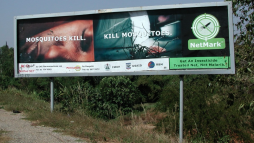malaria
Posted by ccarlon on Oct 11, 2011
“SMS for Life“: Use of stock information to improve supply chain data sheet 670 Views
Author:
Barrington, Jim, Olympia Wereko-Brobby and René Ziegler
Abstract:
Stock-outs of malaria treatments at the health facility level in many sub-Saharan African countries have been a persistent problem for many years. A stock-out is the unavailability of medicine at the health facility. In Tanzania, 93 % of the population are at risk for malaria infection. The number of malaria cases is estimated to be 11 million resulting into 60-80 thousand deaths per year or 220 deaths per day in Tanzania alone. The goal of the SMS for Life pilot project was to develop a flexible and scalable solution to bring up-to-date visibility of anti-malarials within the Tanzanian Public Health Sector with a potential to reduce or eliminate stock-outs of five drugs (four dosage forms of ACTs and Quinine Injectable) in all health facilities in a pilot sample of three districts.
Initiated and led by Novartis, a public-private partnership was established with the Roll Back Malaria Partnership, IBM, Vodafone and the Ministry of Health in Tanzania. This unique partnership developed a solution using mobile phones, SMS messages, internet and mapping technology to visualize weekly stock inventory of Artemisinin Combination Therapy (ACTs) and Quinine Injectable at 129 health facilities and 226 villages. Over the course of one year, the Project Team designed the system, created a data repository, trained key staff and implemented the solution for a 21-week pilot in three districts of Tanzania: Ulanga, Kigoma Rural and Lindi Rural. These districts are located in three different regions and supplied from different Zonal Stores with a catchment population of 1.2 million people.
Posted by MohiniBhavsar on Aug 14, 2010
Monitoring and Evaluation Report of PDAs for Malaria Monitoring in Maputo Province, Mozambique: Final Report data sheet 1731 Views
Abstract:
The overall goal of the PDAs for Malaria Monitoring in Maputo and Gaza Provinces, Centre was to improve the management of public health dat using handheld computers in order to provide the malaria program the Lubombo Spatial Development Initiative (LSDI) with appropriate assessment tools and the ability to make informed decisions.
The specific objectives of the project that would contribute to the achievement of the overall goal were
- to enable personnel from District level of the health service to collect data and provide it to the Provincial level in a timely fashion;
- to develop training courses and appropriate collection tools designed for use with handheld computers; and
- to evaluate the utility of handheld computers for the malaria control program to provide data rapidly and accurately to allow better targeting of interventions and resources.
AED-SATELLIFE developed and successfully deployed electronic data collection tools which catalog drug and rapid diagnostic test stocks; spray operators daily work performance; weekly health facility data; localization of individual households with GPS, including demographic data on household members, house structure and divisions; and health facility surveys linked to GPS positioning. Training materials were developed inPortuguese.
Independent evaluation confirmed that the electronic data collection/transmission tools proved to be a useful, adoptable, and result in higher user satisfaction compared to paper based approaches. Some challenges need to be addressed before there can be widespread adoption of the technology, such as limited infrastructure, especially cellular coverage.
Posted by MohiniBhavsar on Jul 06, 2010
Every ChildCounts: The Use of SMS in Kenya to Support the Community-Based Management of Acute Malnutrition & Malaria in Children data sheet 2720 Views
Author:
Berg, Matt, Wariero, James, and Modi, Vijay
Abstract:
Baseline under five child mortality in Sauri, Kenya as of 2005 was estimated to be 148 deaths per 1000 live births. By 2008, the rate had dropped to 81 deaths per 1000 live births due to Millennium Village Project (MVP) interventions. A review of child deaths revealed that among other causes, such as malaria, acute febrile illnesses, diarrheal illnesses and HIV, malnutrition contributed to more than 50% of all child deaths. Community health workers (CHWs) led several interventions, namely community-based management of acute malnutrition, home-based testing for malaria and diarrheal illnesses and immediate dispersal of appropriate treatments.
To support these interventions, MVP ran a pilot project where CHWs were equipped with mobile phones to use SMS text messages to register patients and send in their data with the goal of improving child health and empowering community health workers. This report seeks to detail the methods used, illustrate early results and initial findings of the ChildCount mHealth platform that CHWs have now been using since early July of 2009.
Posted by PenelopeChester on May 25, 2010
The human and economic cost of malaria in Nigeria is staggering. There are currently 110 million clinically diagnosed cases in a population of 151 million. Malaria kills 250,000 children under five years old in Nigeria every year, and is the cause of 11% of maternal deaths. 60% of out-patient visits and 30% of hospitalizations in the country are malaria-related.
In addition to the enormous toll malaria takes on public health, it is also expensive. 132 billion Naira (USD $870 million) is lost every year in the form of malaria prevention and treatment costs and from the loss of overall economic productivity.
And yet in spite of the risk malaria poses to the Nigerian people, health surveys from 2006 to 2008 indicated that only 8% of households in the country owned at least one insecticide-treated net (So-called ITNs).
| Malaria Kills: Distributing 63 Million Bednets in Nigeria with RapidSMS data sheet 10344 Views |
| Countries: |
Nigeria
|

